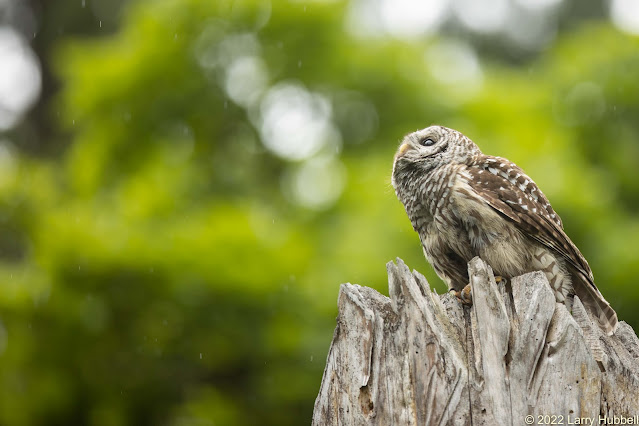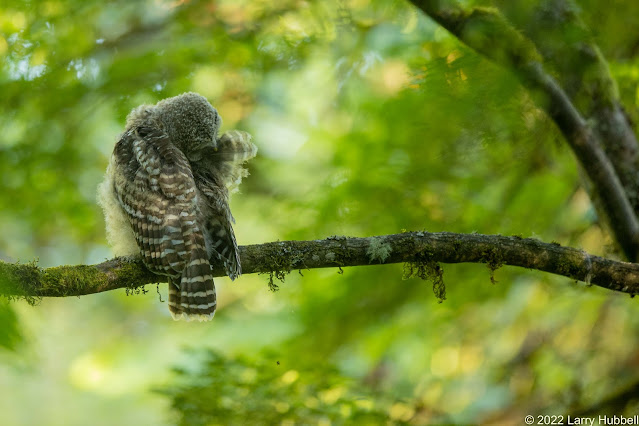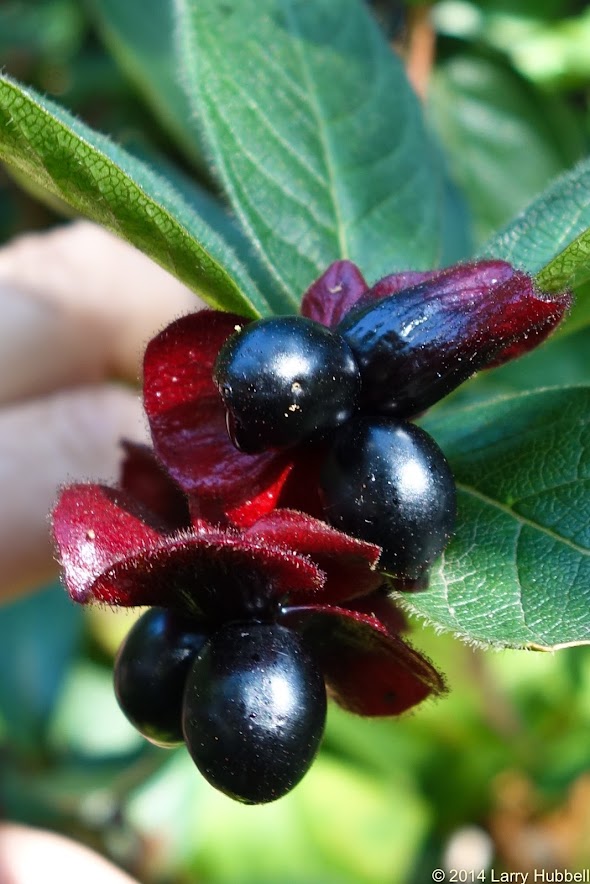 This photo was taken on Friday, June 3rd, 2022 by Fei Cheng (Thank You!) and relayed by Jeff Graham (Thank You!).
This photo was taken on Friday, June 3rd, 2022 by Fei Cheng (Thank You!) and relayed by Jeff Graham (Thank You!).
This young eagle was photographed almost directly below its nest. It is a bit early for a young eagle to be out of the eyrie. Click Here to see the eaglet photos taken about two months ago.
Most often, the young eagles from Monty and Marsha's nests have fledged in mid-July. I suspect this young bird may be premature in leaving the nest, but Marsha may have also laid her eggs earlier this year. I have heard that as birds mature the reproductive process often commences more quickly.
Even though the young one is almost the size of an adult it apparently could not fly. Without the ability to escape to an overhead branch it would have been easily injured by an off-leash dog, a coyote, or even a raccoon or an otter. Although, given the development of its talons and bill it might have inflicted some damage if it had been attacked. In a situation like this, with a young flightless bird on the ground, it is best for all involved to quickly contact the Animal Control group at the Seattle Animal Shelter. This photo was also taken a bit later on Friday, June 3rd, 2022 by Fei Cheng.
Thank you to Seattle Animal Control and to everyone who helped to get them on site. The young eagle was picked up and kept safe overnight. The next day it was transported to PAWS (Progressive Animal Welfare Society) in Lynnwood. We are still waiting to hear the young bird's prognosis.
In the meantime, Jeff Brown suspects the young eagle has a (hopefully) minor bone fracture in the wing (Thank You, Jeff). If the wing heals quickly and the bird learns to fly, then it could potentially be released near the nest. If the young eagle can rejoin the family, while its sibling is in the neighborhood and still being fed by the parents, there is a good chance that the adults will resume feeding it.
Click Here if you would like to read about the 2019 release of a very similar young eagle from this same nest site.
This photo was also taken on Friday, June 3rd, 2022 by Fei Cheng.
Susan, a nearby neighbor, asked if I thought the young bird might have been accidentally pushed from the nest. In previous years, when other offspring left the nest early, it was often due to part of the nest falling. In this case, the nest appears to still be intact. So, Susan's scenario deserves serious consideration.
Could the young eagle, who is still in the nest tree, have accidentally knocked its sibling to the ground?
This photo is from last Monday, the remaining young eagle appeared to be excited when one of the adults caught a fish and headed toward the nest.
After eating the young bird began exercising its wings. It is the young bird's wing we see behind the adult's head. Looking closely we see the primary feathers (at the tip of the wing) are not yet fully developed and their attachment to the wing is not yet hidden by coverts i.e. the quills are exposed. (Quills are the portion of the feather you would hold if you were using a feather as a pen.) Coverts help to create a single smooth and functional wing surface.
This 2018 photo shows the adults and an early version of the nest at the same location. The fully-developed primary feathers on the incoming eagle's wing are much longer and the coverts on the inner portion of the wing cover the calamus or quill.
By zooming in a bit we can see the quills on the young bird's wing more clearly. It is also interesting to note that the adult eagle's eyes are wide open in this photo.
Literally, one second later the adult's nictitating membrane sweeps back across the eye.
Zooming in we can see the membrane more easily.
The transparent nictitating membrane provides protection for the eye while allowing the eagle to see through it. I believe utilizing the membrane is an involuntary, instantaneous reaction that occurs when the subconscious determines the eye might be in danger - similar to when we blink before being hit. It can also happen when an eagle has live prey in its bill that is flailing about trying to get free.
In the photos above, the adult and the young eagle were on opposite sides of the nest. Nonetheless, the adult's subconscious reaction implies that the young eagle's wings were long enough to reach across the nest and potentially damage its eye. This supports Susan's idea that the young eagle in the nest might have bumped the other young bird with its wing.
While we are on the subject of eyes it is interesting to notice the way they change as the eagles mature. This young bird, from the same nest in 2018, was about the same age as the current set of young eagles. Note the dark color of the eye, the yellow at the base of the bill, and the dark tip. This color arrangement is very similar to this year's young eagles.
This eagle, was in its second calendar year, i.e. about one year old, when this photo was taken near Port Townsend. The colors on the bill changed a bit. The yellow has expanded and the tip of the bill is getting lighter. However, it is the color of the iris which is most dramatically different.
In addition to the color changes of the eyes and bill, there is another clue to this young eagle's age. When it flew it exposed the varied lengths of its secondary flight feathers. If you want to understand how this relates to the age of a Bald Eagle Click Here.
By the time an eagle is fully mature, after four or five years, the bill is totally yellow and the irises are pale yellow-white.
Returning to our current lonely young eagle, this photo demonstrates the length of its wings relative to the size of the nest. Although, admittedly much of the nest is hidden.
By looking at the nest, before the cottonwood tree leafed out, we get a better idea of the size of the nest. When compared with the length of the young eagle's wings, in the prior photo, it seems quite possible that the flapping wings may have (reached and) bumped the sibling out of the nest.
There is a silver lining in the fallen eagle's situation. The Urban Raptor Conservancy now has ID bands that fit young eagles which they are willing to apply. (Thank You to the URC team!). So, if the wayward young eagle heals up and is released near the nest it should be wearing some new jewelry. The uniquely coded band will enable it to be identified whenever, and wherever, it is seen. If the healing, release, and banding work out as planned, later this summer, we may be able to learn how long the recovered young eagle remains around Union Bay.
Its sibling on the other hand is already getting lift and becoming slightly airborne. I suspect it will be totally out of the nest before mid-July. Either way, it will be fun to watch for its first flight.
Yesterday evening, June 11th, I stopped back by to check on the remaining young eagle. The nest looked empty from the south.
There was no sign of the young eagle from the north side either. I knew the young bird could be sleeping out of sight in the middle of the nest. Also, it might have walked out on a branch and climbed into the foliage, where I could not see it. Or, although it seemed unlikely, it might have learned to fly and joined the parents elsewhere.
I was too bored to sit and wait, so I went looking for the parents on the off chance that the young eagle might be with them.
I found Monty sitting on a birch snag on the small island just north of the Waterfront Activities Center. He was being harassed by a male Red-winged Blackbird who obviously disapproved of the Bald Eagle's presence in his territory.
Marsha was in a taller snag on the shore, just behind Monty. She was being harassed by an American Crow. I could not see any sign of a young eagle. After a time, Monty took a spin out and about Union Bay. When he returned he landed in a tree near Marsha.
Suddenly, I noticed the missing sounds of a young eagle begging for food. If the young bird had seen Monty's hunting expedition I felt certain it would have begun calling loudly for food. This led me to conclude the young eagle was mostly like still in the nest tree south of Montlake Cut.
Sure enough, when I returned to the nest site, the young bird was about six feet out on the branch. The one horizontal branch that is level with the nest. The youngster has begun the branching process. Hopefully, this one learns to fly before it falls.
Have a great day on Union Bay...where nature lives in the city!
Larry
Going Native:
Each of us, who breathe the air and drink the local water, needs to watch and protect our local environment. Native plants and trees encourage the largest diversity of lifeforms because of their long intertwined history with our local environment and native creatures. Even the microbes in the soil are native to each local landscape.
I hope we can inspire ourselves, our neighbors, and local businesses to respect native flora and to support native wildlife at every opportunity. I have learned that our most logical approach to native trees and plants (in order of priority) should be to:
1) Learn and leave established native flora undisturbed.
2) Remove invasive species and then wait to see if native plants begin to grow without assistance. (When native plants start on their own, then these plants or trees are likely the most appropriate flora for the habitat.)
3) Scatter seeds from nearby native plants in a similar habitat.
4) If you feel you must add a new plant then select a native plant while considering how the plant fits with the specific habitat and understanding the plant's logical place in the normal succession of native plants.
***************
My friend Elaine Chuang shared several resources (that were new to me) from the January 2022 Washington Ornithological Society meeting. The major new concept is that specific keystone native plants enable critical moths and caterpillars that in turn provide food for the great majority of birds, especially during the breeding season. Here are the top two links from her list.
Native Keystone Plants for Wildlife:
https://www.youtube.com/watch?v=O5cXccWx030
Resources for adding plants to your Pacific Northwest Garden:
https://wos.org/wos-wp/wp-content/uploads/2021/12/native-plant-resources-v2.pdf
***************
In the area below it is my intention to display at least one photo each week to help challenge us to know the difference between native and non-native lifeforms.
What is this native plant with the yellow flower, which is currently blossoming in Seattle?
Scroll down for the answer.
******************
Black Twinberry: Most Twinberry plants seem to be flowering now but a few have already begun to develop the black berries. Hummingbirds, both the Anna's and the Rufous species', love the flowers. Many sources state the berries are eaten by a variety of birds but so far I have not been lucky enough to see it happen. Maybe this will be the year!
*****************
The Email Challenge:
Over the years, I have had many readers tell me that Google is no longer sending them email announcements. As of 2021, Google has discontinued the service.
In response, I have set up my own email list. With each post, I will manually send out an announcement. If you would like to be added to my personal email list please send me an email requesting to be added. Something like:
Larry, I want to see more of nature. Please add me to your personal email list.
Thank you for your patience and interest!
My email address is:
LDHubbell@comcast.net
*******************
The Comment Challenge:
Another common issue is losing your input while attempting to leave a comment on this blog. Often everything functions fine, however, sometimes people are unable to make it past the robot-detection challenge or maybe it is the lack of a Google account. I am uncertain about the precise issue. Sadly, a person can lose their comment with no recovery recourse.
Bottom Line:
If you write a long comment, please, copy it before hitting enter. Then, if the comment function fails to record your information, you can send the comment directly to me using email.
My email address is:
LDHubbell@comcast.net
Sincerely,
Larry













































